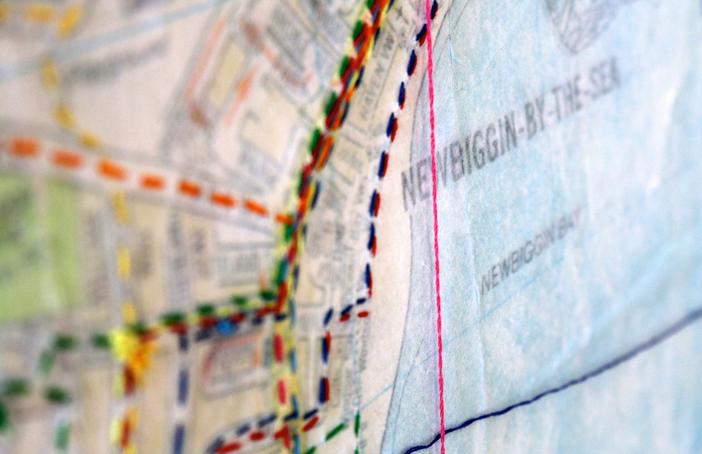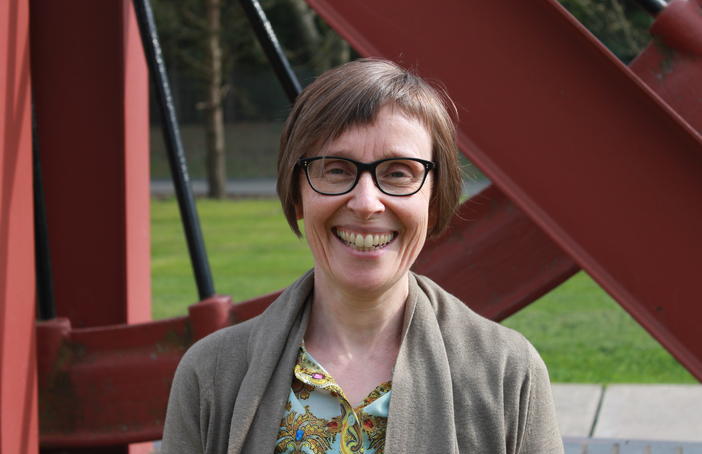Blog Post
In conversation: the role of the critical friend
Rachel Adam, Director of bait and Mark Robinson of Thinking Practice talk to Eleanor Turney about their relationship and wider scope of the critical friend role.

Each Creative People and Places project has a ‘critical friend’ – there for guidance, advice and constructive criticism. Rachel Adam, Director of bait and Mark Robinson of Thinking Practice chatted to Eleanor Turney about their relationship and wider scope of having a critical friend on hand.
Rachel Adam: We’re from bait, the south east Northumberland Creative People and Places project, and we’ve been going now since autumn 2013. The area that we’re working in has a population of about 142,000 people. We appointed Mark as the critical friend fairly early on.
The first thing that Mark worked on with us was establishing a theory-of-change model, so that we could track progress against our mission and be clear about whether we were on track. A feature of this area is there are very few arts organisations, and that meant we needed to work in partnership with organisations from pretty much every other sector, but with a particular focus on voluntary and community sector organisations . Do you think that’s a fair summary?
Mark Robinson: Yes, I think so. The critical friend posts were something Arts Council England wanted all the CPP projects to have, with specific connection to evaluation. Hence that first question, and hence the approach that we’ve taken since.
Eleanor Turney: A key feature of the CPP projects is that they use local knowledge to be flexible and to be useful to the communities in which they’re working; there isn’t a one-size-fits-all model. Do you think that’s a fair assessment of the role of the critical friend as well?
MR: It’s certainly how it’s worked out in practice. There are no two of us doing it in exactly the same way. It gets tailored depending on the skills of the critical friend, as well. I think there’s a bit of variation there, depending on what each person’s bringing.
RA: I think it’s a hard part to play, actually. What Mark is enabling us to do is ensure we are on track, but it actually grew to be valuable in other ways. I think having somebody who gives that regular reflection back to us – ‘This is what I hear you’re saying’ – has proved to be really, really valuable.
ET: I wonder if we can take the critical friend idea and separate it out: the idea of having a critic on side, and then the idea of having the friend who you can bounce ideas off. Have you found that different points of the project have called for different aspects of that relationship?
RA: The ‘friend’ part is about a sense of shared values and purpose, so we know Mark buys into what we’re doing; we know that he understands what we’re trying to do. The fact that the critical friend relationship is over several years is important — it’s longitudinal but it’s not every day. You’re working with someone who has a bigger understanding of what you’re doing, that’s the ‘friend’ bit. The ‘critical’ bit is around the rigour of the analysis. If you put those two things together, the phrase ‘critical friend’ is actually quite a good one. There is a potential double meaning within the word ‘critical’, too, as in ‘essential to us being able to do our job’, and then as in ‘can be critical’. He can challenge what we’re doing because there is an understanding of what we’re trying to achieve. Does that chime, Mark?
MR: It does. I’d agree with all of that. It’s been about understanding and helping the team to articulate what it is they’re trying to do. A lot of our conversations have been about reflecting on performance. I absolutely agree with Rachel. The length of time this has gone on is really important and helpful – it’s really good to have that continuity.
ET: Fantastic! My next question is what skills you think a critical friend needs to have?
MR: The ability to ask the right questions at the right time, and to listen to the answers properly. I think there have been times where I’ve helped Rachel and the team to re-frame what they’re trying to do, because sometimes when you’re a team you get into a particular frame. It’s really important for the critical friend to sometimes say: ‘think about it like this, then how does it feel?’
RA: Yes, I think there have been moments where Mark has enabled us to put ourselves into the shoes of other people, and that’s been really valuable. I tried to imagine what doing the project over the last two-and-a-half years would have been like without the critical friend, and I think we would have gone down many more rabbit holes.
ET: Because this relationship has been ongoing for a while now, do you occasionally find you’ve internalised that critical-friend voice? And, if so, has it made the process easier?
RA: It does make things easier, yes. We do use the toolkit that Mark’s been giving us as we go along, so that’s been invaluable. We have an evaluation team as well, and having them and Mark gives a richer perspective on the whole project. What’s also interesting is where you get the reflection back from both places, and you can kind of check in and go ‘Oh yes , actually, the perspective of both those places is the same, so we must be right.’ I mean, ‘we must be right’ is a dangerous thing to say, but we’re more likely to be right.
ET: For you to do a useful job here, Mark, you have to manage to be both objective about the project as a whole but also care about its overall aims. Is that a fair statement?
MR: Yes, I think that’s absolutely right.
ET: How do you hold those things in balance, then? Do you hold those things in balance?
MR: I think I do. I think I’m looking at the facts and the realities of what happens as a result of an intervention, and then trying to separate the fact from the feeling. Then you have to understand the facts from different perspectives, to make as much sense of it as you can. When you do that that, you get to the ‘So what? What should we do? How should we be?’ questions about the work. So that’s where the two things come together – you can’t fully separate the facts and the feeling if you’re too emotionally involved. You can’t really help people through this process if you don’t care about the work in the first place.
ET: Okay. And then I guess for you, Rachel, the same applies? You have to care about doing this kind of work or why would you be doing it, but at the same time you need to be objective enough to deliver the most rational, cost-effective, useful project. How has having this extra pair of eyes been useful to that process?
RA: It was particularly useful when we were bidding for funding for the next stage of the programme. We were one of the first seven CPP areas to bid to keep the programme going through to 2019, but we knew from the word go that we would need to do it on a smaller scale — we would have to focus in because we couldn’t continue to do everything. Having Mark’s input thinking that through has meant that we were really clear about where we’d got to. We’re now much sharper about what shape the programme will take for the next three years. Having somebody to talk that through with, has made it actually feel very straightforward.
ET: Fantastic. Is there anything else about the process that strikes you particularly? It feels like a way of formalising a relationship that lots of people might otherwise have in less formal ways.
MR: I think that’s right. Often people will have sounding boards, either formal or informal that they use, but I think it’s important that this has given it a structure.
RA: When I came into this project, a critical friend isn’t something that I would have thought of building into the project unless it had been a requirement. Actually, it has been so essential that I will want there to be a critical friend written into any other complex projects I undertake. It’s absolutely worth its weight in gold.
MR: We’ve made it all sound quite serious and high-minded. It has its enjoyable set of working conversations, I think. Would you agree with that, Rachel?
RA: I would!
ET: Final question, then: do you have any tips or advice for making the critical friend relationship work as well as yours seems to?
MR: I’d say: be clear at the start what you want out of the relationship, have a plan for what you want to work on and how, but be flexible about changing it, and keep reviewing how you are working and what on. Also, both parties should use the work to learn and try new approaches.
RA: I completely agree with Mark. To give a flavour of how this works, once a year Mark puts together a report, giving a roundup of all the work we've done together. Flowing out of this, we map how we think we'll use his days over the following 12 months, with most detail around the immediate six months. This helps us focus on how best to use the time, and still keep flexibility to explore particular themes or topics as and when they become relevant. There's also something significant in the amount of time available. Twelve days a year is enough to ensure rich, detailed discussions, but not so much that the relationship becomes 'everyday'. When I book in Mark's time with the team, there's a sense that the sessions sit outside our day-to-day work, providing the right amount of space and time to move our thinking on.
"I will want there to be a critical friend written into any other complex projects I undertake. It’s absolutely worth its weight in gold." Rachel Adam


Mark Robinson. Photo: Kev Howard Creative Photography







